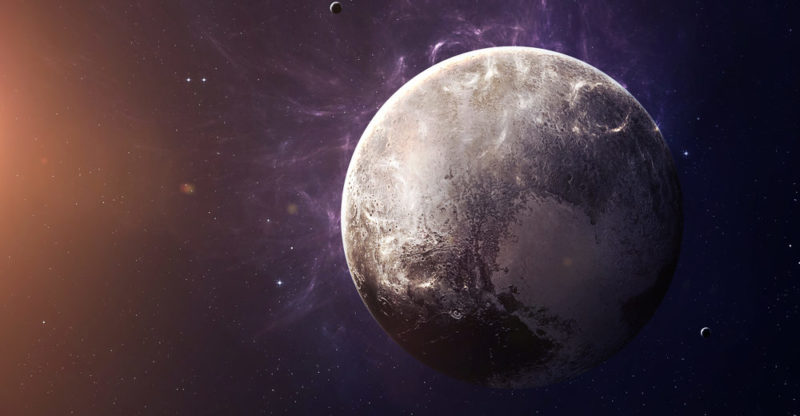We explain what Pluto is, its location in the solar system and its dimensions. Also, what are its characteristics, its climate and geological composition.

What is Pluto?
Pluto is a dwarf planet, that is, a spherical celestial body that orbits the planet. Sun.
The International Astronomical Union (UAI) determines that to be considered a planet, a celestial object, in addition to orbiting the Sun and having a spherical shape, must have a “clean” orbit, that is, it must not have objects of similar size. that orbit alongside it. Because there are numerous objects of similar size in Pluto’s orbit, it is considered that it does not meet the third established criterion, which is why since 2006 it was no longer considered a planet.
Pluto is a dwarf planet located in the Kuiper belt.which is an area full of icy objects and other dwarf planets. It is the celestial object within the solar system that is furthest from the Sun, and for this reason it has a very low temperature, approximately -240 °C.
Pluto is named after the god of the underworld in Roman mythology. This name was proposed by Venetia Burney, an eleven-year-old British girl, shortly after the dwarf planet was discovered in 1930. The proposal was well received and the name Pluto was officially adopted on March 24, 1930. The choice of the name reflects the cold and distant conditions of Pluto, as the underworld in mythology has been commonly associated with dark and distant places.
Characteristics of Pluto
The main characteristics of Pluto are:
- It is the celestial body in the solar system furthest from the Sun.
- It was discovered in 1930.
- In 2006 it was no longer considered a planet and was classified as a dwarf planet.
- It has an average temperature of -240 °C.
- It takes 247 years to orbit the Sun.
- It takes 17 and a half years to make a complete revolution on its own axis.
- Charon is its most important natural satellite.
- The first exploration of the planet occurred in 2015.
Location and dimensions of Pluto
Pluto is located in the region of the solar system known as the Kuiper Belt.which contains a large number of small, icy bodies. This dwarf planet has an eccentric, elliptical orbit that takes it much further from the Sun than the inner planets. This means that its orbit forms an ellipse, that is, an elongated circle, and the Sun is not in the center, but closer to one of the ends.
Regarding the dimensions, Pluto is smaller than the planets in the solar system. Its diameter is approximately 2,376 kilometers, making it even smaller than several of the natural satellites in the solar system, including the Moon.
Pluto also has a large moon called Charon, which is about half its size. In addition, it has other smaller satellites, such as Nix and Hydra.
Composition of Pluto
Detailed information about Pluto’s composition was obtained primarily through NASA’s New Horizons mission, which performed a close flyby of Pluto in July 2015. Before this mission, Pluto was just a distant point of light in images. telescopic, and very little was known about its surface and geological characteristics.
The geology of Pluto revealed by New Horizons showed a diverse and complex surface. Some of its highlights are:
- ice mountains. Pluto has mountain ranges made primarily of ice. These, known as the Wright Mountains, reach heights of up to 3,500 meters.
- frozen plains. Extensive icy plains were observed on Pluto’s surface, such as the Sputnik Planitia region. These plains are mostly composed of frozen nitrogen, methane, and carbon monoxide.
- Nitrogen geysers. New Horizons detected evidence of recent geological activity on Pluto. There are believed to be nitrogen geysers emanating from the surface, similar to the ice geysers observed on some moons of Jupiter and Saturn.
- Canyons and fractures. Canyons and fractures were found on the surface of Pluto. These characteristics could be due to the disappearance of large surface layers of ice due to breakage or melting due to the planet’s internal activity.
Pluto’s atmosphere
Pluto’s atmosphere is thin compared to the largest planets in the solar system. It is composed mainly of nitrogen, followed by carbon monoxide and methane.
Regarding its temperature, Pluto exhibits an extremely cold climate due to its great distance from the Sun.. Surface temperatures range around -240°C, making it one of the coldest places in the solar system. Despite Pluto’s low gravity and low mass, its atmosphere undergoes seasonal changes as it orbits the Sun, impacting its density and composition.
Pluto Satellites

The most important natural satellites of Pluto are:
- Charon. It was discovered in 1978. It is half the diameter of Pluto and about the same mass.
- Nix and Hydra. They were discovered in 2005 by the Hubble Space Telescope.
- Cerberus and Styx. They were discovered by the Hubble telescope in 2011 and orbit the system composed of Charon and Pluto.
Discovery of Pluto

With the technology that observatories had in the 19th century, Pluto was not yet visible. However, astronomers knew that the orbit of each planet is affected by the presence of other nearby planets in the same system.
Thus, scientists had already discovered Neptune (eighth planet in the solar system), despite not being able to observe it, due to the way in which it disturbed the orbit of Uranus (seventh planet in the solar system). However, at the end of the 19th century they discovered that the disturbances in the orbit of Uranus were due to the presence of another planet, in addition to Neptune.
With the theoretical hypothesis of its existence, the search began and the discovery of Pluto was reached on March 13, 1930 at the Lowell Observatory, in the United States.
Explorations to Pluto
Exploration of Pluto presents great challenges due to its distance from Earth. Since its discovery in 1930, it was studied through telescopic observations. Only on July 14, 2015, when NASA’s New Horizons space probe was able to perform a close flyby, was the first detailed view of Pluto available. and its moon Charon, as well as its other small moons and its atmosphere.
The New Horizons mission made it possible to make close observations and collect data on the composition of Pluto’s surface, atmosphere and geology. Since New Horizons’ flyby in 2015, the probe has continued its journey toward the Kuiper Belt, providing information about other objects in this distant region of the solar system.
Why is Pluto not a planet?
The recategorization of Pluto as a dwarf planet, that is, a category different from that of a conventional planet, It is largely due to the discovery in 1992 of numerous celestial bodies orbiting beyond Neptune endowed with physical and orbital characteristics very similar to those of Pluto. This led scientists to wonder if Pluto was not rather part of this heterogeneous community of small space bodies, all located in the Kuiper Belt.
The debate in the scientific community was immediate, despite the fact that there were precedents for this change: Ceres, Pallas, Juno and Vesta, belonging to the asteroid belt after Mars, were once also considered as possible planets and later recategorized as asteroids.
Thus, as more and more trans-Neptunian objects similar to Pluto were discovered (such as Quaoar, 1070 km in diameter, almost half of Pluto; or Sedna, 1000 km in diameter), the scientific discussion intensified, as the idea gained arguments. that Pluto did not belong to the ordinary planets of the solar system.
In 2005, Eris, a trans-Neptunian object 2,326 km in diameter, slightly larger than the size of Pluto, was discovered and the astronomical community was forced to choose between considering the new discovery as a tenth planet, or rather removing Pluto from the planetary list and creating a new category for these small planets, which was “dwarf planets.” . In 2006, the International Astronomical Union issued its verdict: Pluto was no longer a planet and entered the list of “dwarf planets”.
From then on, for a celestial body to be considered a planet, it must meet the following three requirements:
- It must be in orbit around the Sun (Pluto does this).
- It must have enough mass so that its own gravity has given it a rounded shape, that is, its gravity has led it to hydrostatic equilibrium (Pluto does this).
- It must have orbital dominance, that is, with sufficient gravity to clear its orbit of other similar celestial objects, attracting them towards itself until it collides with them and absorbs them, or converts them into satellites that orbit around it. (Pluto does not do this, as it has only 0.07 times the total mass of its neighbors and therefore insufficient gravity to take over its orbit).
Those stars that meet only two of these requirements are considered “dwarf planets,” as are many other trans-Neptunian objects.
References
- Canseco, K. and Nuñez, M. (2021). Why hasn’t Pluto been a planet for 15 years? UNAM Global Magazine. https://unamglobal.unam.mx/
- Milo, A. (2023). This is Pluto, the first dwarf planet in the Solar System. National Geographic in Spanish. https://www.ngenespanol.com/
- NASA Science. (2021). All about Pluto. https://spaceplace.nasa.gov/





